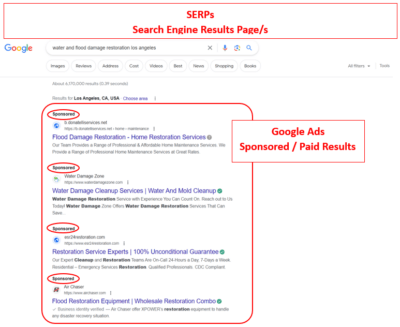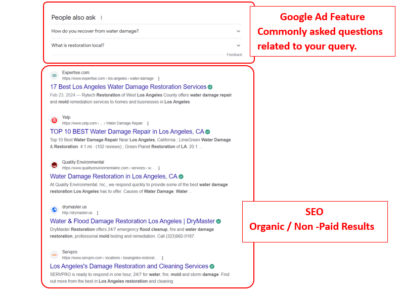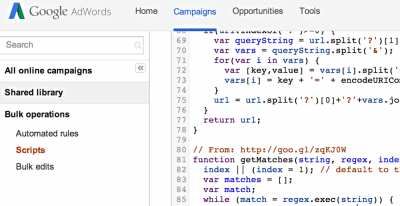In the aftermath of a water disaster, people seek immediate and reliable solutions. In today’s digital age, their search for help often starts online. This is where SEO for water and flood damage restoration companies becomes crucial. By implementing effective SEO strategies, you can ensure your company appears at the top of search results when potential customers in your local area need your services most.
Table of Contents
ToggleUnderstanding SEO for Water and flood damage restoration
SEO is the practice of optimizing your website and online presence to improve its visibility in search engine results pages (SERPs). The higher your website ranks for relevant keywords, the more likely potential customers are to find you when they search for services like “water damage restoration near me” or “floor restoration company [city, state].”


Why is SEO important for water and flood damage restoration companies?
- Increased website traffic: If your website ranks higher in search results, it will get more visitors, which could mean more leads and sales.
- Qualified leads: SEO lets you focus on specific keywords that are related to your services, which brings in customers who are already looking for what you have to offer.
- Local SEO: Local SEO helps people find your business through local searches, which is important if you want to get customers in your service area.
- Brand awareness: Increased website visibility through SEO can build brand awareness and establish your company as a trusted resource.
Want to increase your local presence in your area using SEO?
Getting Started with SEO for Water Damage and Flood Restoration
Keyword Research
As the foundation of any successful SEO strategy, keyword research is especially vital for water damage and flood restoration companies seeking to increase their online visibility. Here’s how companies in this field can do keyword research well:
Identify relevant keywords related to water damage and flood restoration
Start by brainstorming a list of keywords and phrases that potential customers might use when searching for water damage and flood restoration services. This could include terms such as “water damage restoration,” “flood cleanup,” “emergency water removal,” “mold remediation,” and “flood damage repair.” Think about the specific services offered and the problems customers are looking to solve when conducting their searches.
Google Autocomplete, also called Auto-Suggest, your friendly search bar helper, can be a powerful tool for keyword research. Here’s how to unlock its potential:
- Think of a broad topic related to your niche or content. Open your browser and head to Google.
- Start typing your topic in the search bar, but don’t press Enter yet.
- Watch the magic! As you type, Autocomplete will suggest popular searches related to your topic. These are gold nuggets for keyword research!

- Explore the suggestions: See what people are commonly searching for.
- Go deeper: Click on one of the suggestions and see what new suggestions pop up. This helps you discover long-tail keywords, which are more specific and often have lower competition.
- Use a keyword research tool: While Autocomplete gives you initial ideas, consider using a free or paid keyword research tool to analyze search volume and competition for the keywords you discover.
Focus on long-tail keywords with local intent
Long-tail keywords are longer, more specific phrases that typically have lower search volumes but higher conversion rates. For water damage and flood restoration businesses, targeting long-tail keywords with local intent can help narrow down the target audience and attract highly qualified leads. For example, instead of targeting broad keywords like “water damage,” consider long-tail variations such as “emergency water extraction in [city]” or “flood damage restoration near me.”
Utilize keyword research tools
Leverage keyword research tools like Google Keyword Planner, SEMrush, or Ahrefs to identify relevant keywords and gauge their search volumes and competition levels. These tools provide valuable insights into keyword trends, related terms, and search volume data, allowing businesses to make informed decisions about which keywords to target in their SEO efforts. Additionally, explore related keywords and variations to uncover hidden opportunities and expand the reach of your SEO strategy.
Optimizing Website Content
Creating informative and engaging content is essential for water damage and flood restoration businesses to establish authority, educate potential customers, and improve their search engine rankings. Here’s how businesses in this industry can optimize their website content effectively:
Create informative and engaging content addressing common issues related to water damage and flood restoration
Identify the common issues, concerns, and questions that potential customers may have related to water damage and flood restoration. Develop informative and educational content that addresses these topics comprehensively, offering valuable insights, tips, and solutions. Content could include articles, blog posts, how-to guides, FAQs, case studies, and videos covering topics such as water damage prevention, flood cleanup tips, mold remediation techniques, and the importance of professional restoration services.
Incorporate targeted keywords naturally into website copy
Once you’ve identified relevant keywords through keyword research, incorporate them naturally into your website copy to improve search engine visibility. This includes optimizing titles, headings, meta descriptions, and alt tags with targeted keywords while ensuring that the content remains informative and engaging for readers. Avoid keyword stuffing, as this can negatively impact the user experience and search engine rankings. Instead, focus on creating high-quality content that provides value to your audience while strategically integrating keywords to improve search visibility.
- Titles and Headings: Include targeted keywords in page titles and headings to signal relevance to search engines and attract user attention. For example, a blog post titled “5 Essential Steps for Water Damage Restoration After a Flood” could target keywords like “water damage restoration” and “flood cleanup.”

- Meta Descriptions: Write compelling meta descriptions that summarize the content of each page and incorporate targeted keywords to improve click-through rates in search engine results pages (SERPs). Meta descriptions should be concise, informative, and enticing, encouraging users to click through to your website for more information.

- Alt Tags: Optimize image alt tags with descriptive keywords to improve accessibility for visually impaired users and enhance the relevance of images to search engines. Use relevant keywords that accurately describe the content or purpose of each image while avoiding keyword stuffing.
Local SEO for Water and Flood Damage Restoration Strategies
Local search engine optimization (SEO) is vital for water damage and flood restoration businesses to connect with potential customers in their service areas. By implementing effective local SEO strategies, businesses can improve their visibility in local search results, attract more qualified leads, and ultimately, drive growth and success. Here are some key local SEO strategies for water damage and flood restoration companies:
Claim and optimize Google My Business listing
Claiming and optimizing a Google My Business (GMB) listing is one of the most important steps for improving local search visibility. Businesses should ensure that their GMB profile is complete and accurate, including essential information such as business name, address, phone number, website URL, hours of operation, and services offered. Additionally, businesses can add photos, videos, and posts to their GMB listing to enhance engagement and attract potential customers.
Ensure NAP (Name, Address, Phone Number) consistency across all online platforms:
Consistency is key when it comes to NAP information across all online platforms, including business directories, social media profiles, and review websites. Inaccurate or inconsistent NAP information can confuse search engines and potential customers, negatively impacting local search rankings and user experience. Businesses should ensure that their NAP information is consistent and up-to-date across all online platforms to establish trust and credibility with both users and search engines.
Encourage satisfied customers to leave positive reviews
Positive online reviews are a powerful driver of local search visibility and customer trust. Water damage and flood restoration businesses should encourage satisfied customers to leave positive reviews on their GMB listing, as well as other relevant review platforms such as Yelp, Angie’s List, and HomeAdvisor. Responding promptly and professionally to reviews, whether positive or negative, demonstrates a commitment to customer satisfaction and can help improve online reputation and search rankings.
Utilize local keywords and geographic terms in website content
Incorporating local keywords and geographic terms into website content can help water damage and flood restoration businesses rank higher in local search results. Businesses should identify relevant local keywords related to their services and target geographic terms such as city names, neighborhoods, and landmarks. These keywords and terms can be strategically integrated into website content, including page titles, headings, meta descriptions, and body copy, to signal relevance to local search queries and improve search visibility.
Mobile Optimization
In today’s mobile-centric world, having a mobile-friendly website is no longer just a best practice – it’s a necessity for water damage and flood restoration businesses looking to succeed online. Mobile optimization plays a crucial role in providing a seamless and user-friendly experience for visitors accessing websites on smartphones and tablets. Here’s why mobile optimization is essential and how businesses can optimize their websites for mobile devices:
Accessibility: With the widespread adoption of smartphones and tablets, an increasing number of users rely on mobile devices to browse the internet and access information on the go. Having a mobile-friendly website ensures that businesses can reach and engage with this growing segment of mobile users effectively.
User Experience: Mobile-friendly websites provide a better user experience by adapting to the smaller screens and touch-based navigation of mobile devices. Visitors can easily navigate, read content, and interact with the website’s features without experiencing issues like distorted layouts or unresponsive buttons.
Search Engine Rankings: Mobile optimization is a key ranking factor for search engines like Google. Search algorithms prioritize mobile-friendly websites in mobile search results, meaning that businesses with mobile-optimized websites are more likely to rank higher and attract organic traffic from mobile users.
Optimize website design and functionality for mobile devices
Responsive Design: Implement a responsive web design that automatically adjusts the layout and content of the website based on the screen size and orientation of the device being used. Responsive design ensures a consistent and optimized user experience across all devices, eliminating the need for separate mobile and desktop versions of the website.
Mobile-Friendly Navigation: Simplify website navigation for mobile users by using mobile-friendly menus, navigation bars, and buttons. Make it easy for visitors to find the information they’re looking for quickly and intuitively, minimizing the need for excessive scrolling or zooming.
Readable Content: Optimize text size, font styles, and line spacing to ensure that content remains legible and easy to read on smaller screens. Use clear and concise language, and break up long blocks of text into smaller paragraphs or bullet points for better readability on mobile devices.
Ensure fast loading times and easy navigation on smartphones and tablets
Optimize Page Speed: Mobile users expect fast-loading websites, and slow-loading pages can lead to high bounce rates and poor user experience. Optimize website performance by minimizing server response times, compressing images, and reducing unnecessary scripts and code that could slow down page loading times.
Streamlined Design: Keep the design clean and streamlined to reduce clutter and minimize distractions for mobile users. Avoid using large graphics or complex animations that could slow down page rendering or cause performance issues on mobile devices.
Mobile-Friendly Forms: If your website includes contact forms or other interactive elements, ensure that they are optimized for mobile use. Use input fields that are large enough to accommodate touch input, and minimize the number of form fields to streamline the user experience on mobile devices.
Need help optimizing your business website?
Link Building
Link building is a crucial aspect of SEO for water damage and flood restoration businesses aiming to improve website authority, visibility, and search engine rankings. By developing a strategic approach to link building, businesses can increase the number of high-quality backlinks pointing to their websites, signaling to search engines that their content is reputable and valuable. Here’s how businesses in this industry can effectively implement a link-building strategy:
Develop a link-building strategy to improve website authority and visibility
Content Creation: Create high-quality, informative content that addresses common issues, provides valuable insights, and offers solutions related to water damage and flood restoration. Compelling and shareable content naturally attracts links from other websites, improving website authority and visibility over time.
Outreach and Networking: Reach out to industry influencers, bloggers, and relevant websites in the water damage and flood restoration niche to build relationships and opportunities for collaboration. Offer to contribute guest posts, provide expert insights, or participate in interviews to earn backlinks and increase brand exposure.
Competitor Analysis: Conduct competitive analysis to identify websites linking to competitors within the water and flood damage restoration industry. Analyze their backlink profiles to uncover potential link-building opportunities and develop strategies to earn similar or better-quality backlinks for your own website.
Seek opportunities for local citations
Local Directories: Ensure that your business is listed in relevant local directories such as Yelp, Yellow Pages, Angie’s List, and HomeAdvisor. These directories not only provide valuable citations for local SEO but also serve as potential sources of backlinks from authoritative websites.
Industry Associations: Join local and national industry associations related to water damage and flood restoration and ensure that your business is listed in their directories or member listings. Membership in industry associations not only enhances credibility but also provides opportunities for networking and link building within the industry.
Local News Websites: Monitor local news websites and publications for opportunities to contribute expert insights or commentary on water damage and flood restoration topics. By providing valuable insights and expertise, businesses can earn mentions and backlinks from reputable local news sources, further enhancing their online visibility and authority.
Focus on obtaining high-quality backlinks from relevant and authoritative sources
Content Promotion: Promote your content through social media, email marketing, and outreach campaigns to attract attention and earn backlinks from relevant websites and influencers in the water damage and flood restoration industry.
Guest Blogging: Identify reputable websites and blogs within the water damage and flood restoration niche that accept guest contributions. Offer to write high-quality guest posts that provide valuable insights and information to their audience in exchange for a backlink to your website.
Link Reclamation: Monitor your website’s backlink profile regularly to identify any lost or broken links pointing to your website. Reach out to webmasters to request that they update or restore the links, ensuring that you maintain a healthy backlink profile and maximize link-building opportunities.
Technical SEO for Water Damage and Flood Restoration Companies
Technical SEO is the backbone of a successful online presence, ensuring that websites are properly indexed and optimized for search engines. For water damage and flood restoration companies, addressing technical aspects is crucial for enhancing website visibility and improving organic search performance. Here’s how businesses in this industry can leverage technical SEO to their advantage:
Regular Website Audits
Conducting regular website audits is essential for identifying and fixing technical issues that may impact search engine visibility. This includes analyzing website performance, identifying crawl errors, checking for broken links, and ensuring proper implementation of metadata and schema markup. By addressing these issues promptly, businesses can ensure that their websites are optimized for search engine indexing and ranking.
Optimizing Site Structure
Optimizing site structure involves organizing website content in a logical and hierarchical manner to improve navigation and usability for both users and search engines. For water damage and flood restoration companies, this may involve categorizing services, creating landing pages for specific service areas, and implementing breadcrumbs for easy navigation. A well-structured website not only enhances user experience but also makes it easier for search engines to crawl and index content.
Optimizing URL Structure
Optimizing URL structure involves creating descriptive, user-friendly URLs that include relevant keywords and accurately reflect the content of each page. Water damage and flood restoration companies should ensure that URLs are concise, readable, and contain relevant keywords related to their services. Additionally, using hyphens to separate words and avoiding special characters or unnecessary parameters can help improve URL readability and search engine visibility.

Implementing Proper Internal Linking Practices
Internal linking is an important aspect of technical SEO that involves linking between pages within the same website. Water damage and flood restoration companies can improve website navigation and distribute link equity by implementing proper internal linking practices. This includes linking to relevant pages using descriptive anchor text, creating a hierarchical linking structure, and prioritizing pages with high-value content or conversion goals.

Final Thoughts on SEO for Water Damage and Flood Restoration
Investing in comprehensive SEO strategies is essential for water damage and flood restoration companies to thrive in today’s online competitive landscape. By implementing the recommended tactics, monitoring progress, and adapting to changing trends, you can enhance your online visibility, attract qualified leads, and establish your business as a trusted and reliable resource in your local community. Remember, SEO is a long-term commitment, but the potential benefits in terms of increased brand awareness, lead generation, and business growth make it a worthwhile investment for any water damage and flood restoration company.
Start your SEO journey to reach more potential clients. Schedule a call with our team of experts. Find out how using Google Ads may benefit your business as well.









